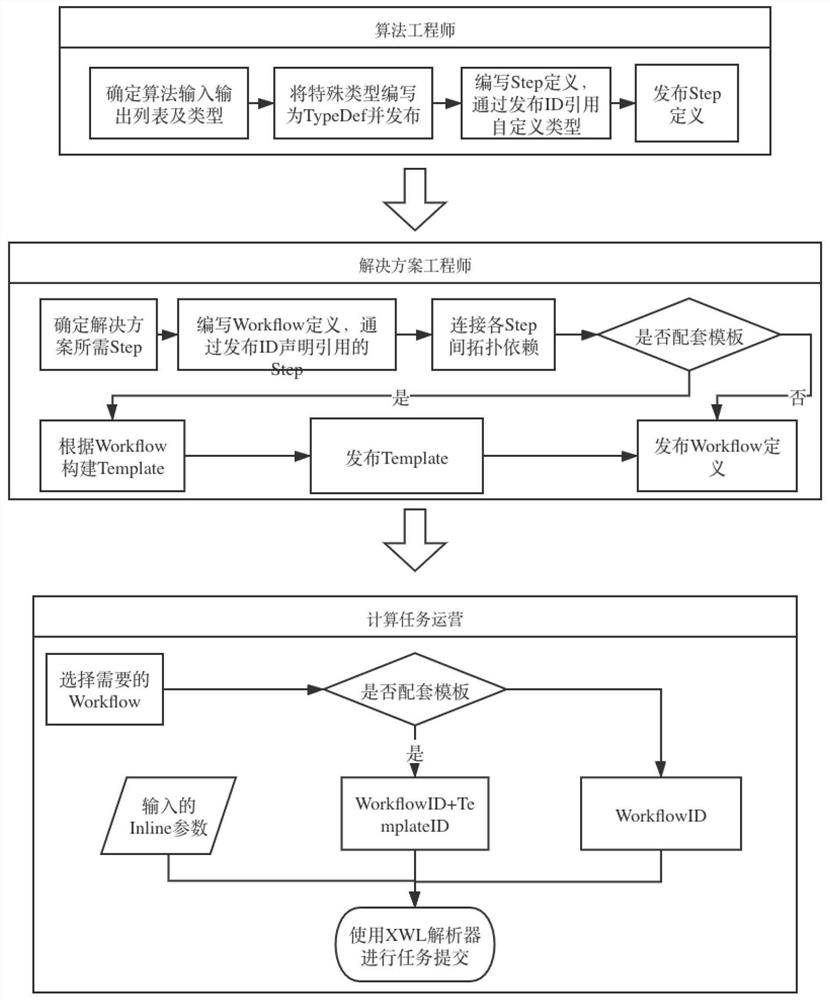Universal description language data system for directed acyclic graph type automatic task flow
A general description and language data technology, applied in the field of cloud computing, can solve problems such as lack of data reuse, lack of parallel description primitives, and inability to provide automatic parallel functions for single-point tasks
- Summary
- Abstract
- Description
- Claims
- Application Information
AI Technical Summary
Problems solved by technology
Method used
Image
Examples
Embodiment 1
[0071] figure 1 Explain the specific hierarchical structure and reference relationship of the language. The specific description of workflow is carried out through four levels, which are TypeDef definition layer, Step definition layer, Workflow definition layer and Template definition layer. The following are examples and introductions of each definition layer:
[0072] The TypeDef layer is not necessary. If users need to use special custom types, they need to write the TypeDef layer. This part mainly abstracts the definition of common or complex composite types, which is convenient for reference and management; the Step layer is a single The description of the task, for the input and output declaration of a docker image or other executors, needs to specifically declare the name, type, document, parameters and other information of each input and output item; the Workflow layer is a workflow composed of one or more Steps, which needs to be Define the dependent topology of the...
Embodiment 2
[0074] xwlVersion describes the version of the description language, which is used to distinguish version iterations brought about by the continuous addition of functions; class describes the type of this document, and there are four types (TypeDef, Step, Workflow, Template); version describes the definition version; author describes the author's information; doc describes the annotations for the document; name describes the name of the document, and the author needs to keep the name unique when writing the same type of document;
[0075] In the description language, a substructure called TypeAndValueDefine is defined, which contains type, name, value and several attributes, and is used to define a variable in detail. The following are three representative TypeAndValueDefine examples:
[0076] $name:
[0077] type: int[]
[0078] const: 1
[0079] value: 1
[0080] ref: $xxx / $xxx
[0081] required: true
[0082] doc: this is a type and value definition demo
[0083] sym...
Embodiment 3
[0102] The following is an example of a TypeDef definition named common (the general information section will not repeat it):
[0103] xwlVersion: 1.0.0
[0104] class: TypeDef
[0105] doc: a structure type def
[0106] author: ziqi.jiang
[0107] name: common
[0108] version: 1.0.0
[0109] typeDefs:
[0110] $jobArgs:
[0111] doc: Contains some info about compute args
[0112] type: record
[0113] fields:
[0114] :cores:
[0115] type: int
[0116] :memory:
[0117] type: int
[0118] The specific steps are:
[0119] Step 1: Define the typeDefs keyword in the outermost layer, and the typeDefs keyword contains some TypeAndValueDefine substructures. For example, the definition declares a record data named struct, and fields is a subkey declaration of record type, which contains two attributes cores and memory;
[0120] Step 2: In the TypeAndValueDefine substructure that uses the type definition, declare it in the type through a fixed-format link. The follow...
PUM
 Login to View More
Login to View More Abstract
Description
Claims
Application Information
 Login to View More
Login to View More - R&D Engineer
- R&D Manager
- IP Professional
- Industry Leading Data Capabilities
- Powerful AI technology
- Patent DNA Extraction
Browse by: Latest US Patents, China's latest patents, Technical Efficacy Thesaurus, Application Domain, Technology Topic, Popular Technical Reports.
© 2024 PatSnap. All rights reserved.Legal|Privacy policy|Modern Slavery Act Transparency Statement|Sitemap|About US| Contact US: help@patsnap.com










